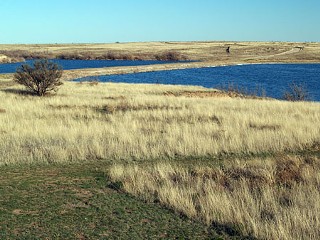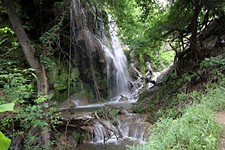Day Trips
The Muleshoe National Wildlife Refuge is an excellent place for birders and nature lovers to soak in the beauty of the great outdoors
By Gerald E. McLeod, Fri., April 20, 2007
The Muleshoe National Wildlife Refuge, northwest of Lubbock, looks like a French landscape painting. The rolling hills covered in a sea of long-stemmed prairie grass seem to move in waves, pushed by the relentless wind under an endless sky. The simplicity of the color palette of this small square of the giant quilt of the state's ecosystems gives the park an uncommon beauty.
"We have a guy from England who visits us every year in the summer on his vacation," says Harold Beierman, manager of the federal preserve. "I guess he comes for the view and the experience."
Muleshoe NWR was the first of 15 wildlife refuges in Texas maintained by the U.S. Fish & Wildlife Service. President Franklin D. Roosevelt established the refuge by executive order in 1935. The 5,809 acres were once part of the XIT Ranch and later the Muleshoe ranches. Beierman says the government paid $25,000 for the property.
Not only does the refuge preserve unspoiled prairie, but the three small lakes at the base of a mesa provide valuable habitat for native and migratory animals. The park has been visited by 321 species of birds including golden and bald eagles.
From September to March, the lakes are the winter home for one of the largest groups of sandhill cranes in the Midwest. Beierman estimates that more than 150,000 sandhill cranes wintered at the refuge this year. The peak year at the refuge for the sandhill cranes was 1981 when 250,000 were counted. The numbers fluctuate each year depending on weather conditions. "The sandhill cranes like the lakes to be about ankle deep," Beierman says. The long-legged birds with 6-foot wingspans and red heads spend their winter days scavenging through plowed fields and their evenings at the lakes.
In wet years, migratory ducks fill the water. Beierman says that more than 13 different kinds of ducks have been spotted in the refuge, including pintails and shovelers. Last year they had more than 1,000 redhead ducks stay for the winter.
The three lakes are really just natural sinkholes that collect runoff from the occasional thunderstorm that sweeps across the open land. Only the smaller Paul's Lake is spring-fed and will hold water much of the year. When full, the three lakes offer 600 acres of salty water.
Beierman says the lakes have nearly three times more salt than what cattle can tolerate. "That might be why the government found a willing seller," he says with a chuckle. A band of saline lakes appears in the rainy season between Lubbock and Clovis. The land and the water aren't good for farming, but the spring and winter grasses are excellent forage for buffalo and, now, for cattle.
After the land was acquired by the government, the Work Projects Administration built dikes to separate the deep end of the pools from the shallow end. "The evaporation rate is a real problem," Beierman says.
For all its serenity, this is still a very rugged place. Despite the pleasantness of spring and fall, winters can be extremely cold and summers brutally hot. Prairie rattlesnakes lurk under rocks, and brown ticks wait for passing hosts. This is not a place you want to go unprepared or oblivious of your immediate environment.
What you get for the long drive is a chance to see a rare section of unspoiled prairie and maybe a porcupine, mule deer, or a bobwhite scamper across the road. The refuge also has a prairie-dog town that covers more than 50 acres.
The Muleshoe National Wildlife Refuge is about 20 miles west of Littlefield or 20 miles south of Muleshoe off TX 214. There is a small primitive campground and picnic area that offers tables, fire rings, and restrooms but precious little shade. Three short hiking trails lead to the lakes. Firebreak roads cut through the tall grass like a faded web and make excellent biking and hiking paths. Six miles of dirt road offer a panoramic view of the refuge and wildlife viewing areas overlook all three of the lakes. Admission to the refuge and camping area is free. For more information, call 806/946-3341 or go to www.fws.gov/southwest/refuges/txrefuges.html.
825th in a series. Day Trips, Vol. 2, a book of "Day Trips" 101-200, is available for $8.95, plus $3.05 for shipping, handling, and tax. Mail to: Day Trips, PO Box 33284, South Austin, TX 78704.









